On August 25, Professor Shen Chen’s team from the Department of Electrical Engineering and Applied Electronics (EEA) at Tsinghua University released the CSEE Standard Test Cases (Electromagnetic Transient Version) based on the CloudPSS simulation platform. The new-type power system standard test cases of CSEE (hereinafter referred to as standard test cases) are Chinese research standard cases publicly released by the Chinese Society for Electrical Engineering (CSEE) and the China Electric Power Research Institute. This series of standard cases focuses on electromechanical transient simulations and covers rotor angle stability, frequency stability, voltage stability, and power frequency overvoltage issues, and can be simulated using PSD-BPA and PSASP electromechanical transient programs.
Based on the PSD-BPA version of the standard cases, Professor Shen’s team constructed seven sets of electromagnetic transient simulation cases using the BPA → CloudPSS conversion tool. The renewable energy models in these cases employ fully white-box OpenCloudPSS open-source models.
The above seven cases are now open-source on the CloudPSS public platform, with all model internal details fully accessible. This allows users to modify the cases to build new scenarios reflecting the characteristics of typical new-type power systems and study their specific security and stability issues.
All CloudPSS simulation results of these cases have been compared with PSD-BPA, PSASP, and other simulation software, with comparative reports provided. Documentation for all seven cases has also been simultaneously open-sourced in the CloudPSS knowledge base.
Users can access the cases and documentation addresses in the “OpenCloudPSS Open-Source Model Library” within the mini-program below. Opening the case links in a browser allows free registration and use. Users who have purchased CloudPSS offline or real-time simulators can also download the cases to their local CloudPSS Mini/Pro simulators.

OpenCloudPSS Open-Source Model Library
(This document is continuously maintained and updated)
Notes on Using the Test Cases
The single-core simulation efficiency of the models on public and private deployment platforms is referenced in the table below. Among them, rotor angle instability and frequency stability cases are large-scale and require longer simulation time. Due to limited public computing resources, it is recommended to download them to local simulators such as CloudPSSMini(RT) or CloudPSSPro(RT). After network partition and parallel optimization, these cases can achieve real-time simulation on the CloudPSSProRT/MiniRT platforms.

*Tested based on Electromagnetic Transient Simulation Core v25.7.25 and Qingyi Tsing-Ev0.3 core.
It should be emphasized that some scenarios in the CSEE standard cases are at the system’s critical stability or instability under extreme operating conditions. According to the basic theory of numerical analysis, the curves obtained from numerical integration cannot reflect the specific process of instability in a real physical system. However, the results of numerical integration still provide important reference value for qualitatively analyzing system stability and stability margins.
Introduction to the Cases
CSEE-RAS Rotor Angle Stability Standard Cases (2 sets)
The transient rotor angle stability CSEE-RAS cases are based on a 500kV two-region AC system as the backbone network, with “one series, one parallel” transmission channels between regions. Two operation modes are provided, corresponding to rotor angle oscillation and rotor angle instability scenarios. In these scenarios, the output share of renewable energy exceeds 50%.
These cases comprehensively reflect two types of rotor angle stability problems and have flexible expandability, serving as foundational cases for research on rotor angle stability analysis and control.

CSEE-RAS System Topology
01 Rotor Angle Oscillation Scenario
A three-phase permanent short-circuit occurs on line B01–B11 at t=4s. At t=4.1s, the faulted line (single circuit) is cleared, triggering dynamic rotor angle oscillations in the sending and receiving-end generators. The rotor angle waveforms of each synchronous machine relative to the receiving-end unit TP11-1 are shown below.
CloudPSS (Electromagnetic Transient) and BPA (Electromechanical Transient) both reproduce the rotor angle oscillation pattern. Due to differences in implementation methods and some internal parameters of DC, renewable energy, and electromechanical/electromagnetic transient models, simulation results differ in details. Additionally, the case is close to the critical stability point, and numerical sensitivity is high; users are advised to treat results with caution.

Relative Rotor Angle Curve – CloudPSS
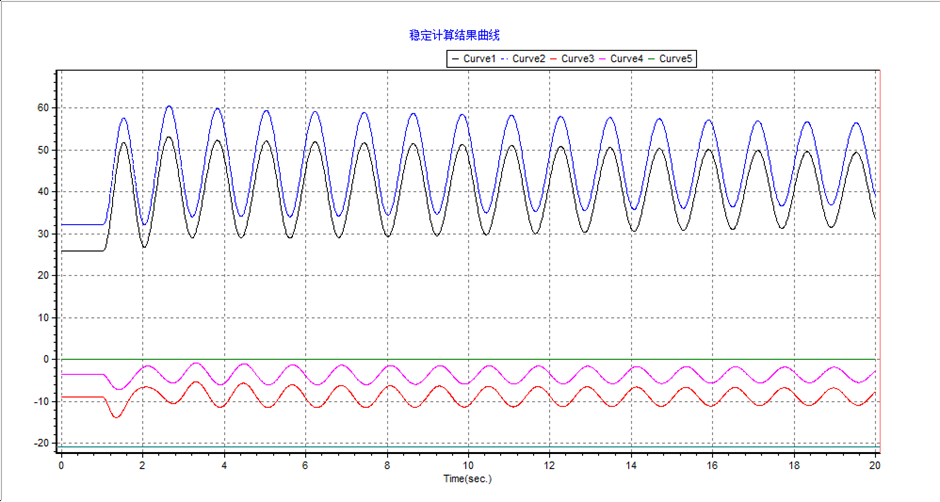
Relative Rotor Angle Curve – BPA
02 Rotor Angle Instability Scenario
Based on the rotor angle oscillation scenario, six additional thermal units and 14 renewable units are added to increase power flow levels. When a three-phase permanent fault on line B11(525kV)–B01(525kV) triggers N-1 conditions, regional rotor angle instability occurs.
CloudPSS (Electromagnetic Transient) and BPA (Electromechanical Transient) both reproduce the rotor angle instability pattern. Due to differences in model implementations and internal parameters, simulation results differ in details. (Note: The numerical curves of instability cannot reflect the actual process of instability in the physical system.)
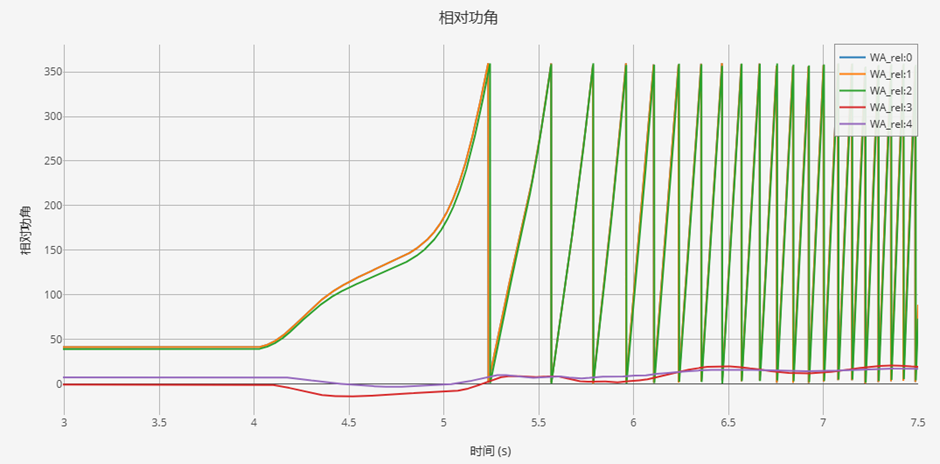
Relative Rotor Angle Curve – CloudPSS

Relative Rotor Angle Curve – BPA
02 CSEE-VS Voltage Stability Standard Cases (2 sets)
The CSEE-VS voltage stability cases focus on the DC receiving end and nearby renewable energy stations, with renewable generation accounting for more than 50% of output. The voltage stability cases include two scenarios: voltage collapse and sustained low voltage. These cases comprehensively reflect the evolution process and key characteristics of sustained low voltage and voltage collapse at the electromagnetic transient scale and serve as foundational cases for studying DC receiving-end grid voltage issues in high renewable penetration scenarios.
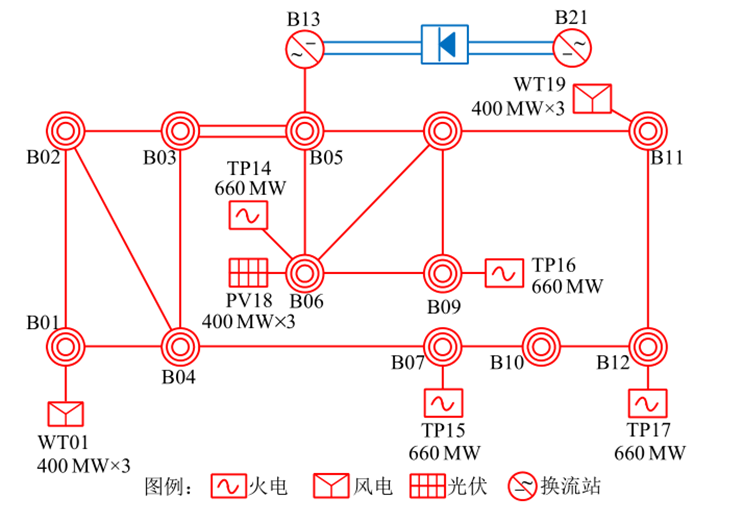
CSEE-VS System Topology
01 Voltage Collapse Scenario
In the double-circuit line between buses B03–B05, one circuit experiences a three-phase permanent short-circuit at t=5.00s. At t=5.09s, the B03-side breaker trips; at t=5.10s, the B05-side breaker trips, simultaneously disconnecting the parallel line. After the fault, the DC converter experiences abnormal oscillations, and all bus voltages remain low. After some time, DC locks and renewable energy disconnects. Voltage waveforms of some system buses are shown below.
CloudPSS (Electromagnetic Transient) and BPA (Electromechanical Transient) both reproduce the voltage collapse. Due to differences in model implementations and internal parameters, simulation results differ in details. (Note: The numerical curves of instability cannot reflect the actual physical process of system instability.)

500kV Bus Voltage – CloudPSS

500kV Bus Voltage – BPA
02 Sustained Low Voltage Scenario
Based on the voltage collapse scenario, two additional synchronous condensers are added, while other parameters remain unchanged.
In the double-circuit line between buses B03–B05, one circuit experiences a three-phase permanent short-circuit at t=5.00s. At t=5.09s, the B03-side breaker trips; at t=5.10s, the B05-side breaker trips, simultaneously disconnecting the parallel line. After the fault, areas near buses B01, B02, B03, and B04 become weak receiving zones, with sustained low voltage and partial renewable energy disconnection. Voltage waveforms of some system buses are shown below.
CloudPSS (Electromagnetic Transient) and BPA (Electromechanical Transient) both reproduce the sustained low voltage issue. Due to differences in model implementations and internal parameters, simulation results differ in details.

500kV Bus Voltage – CloudPSS
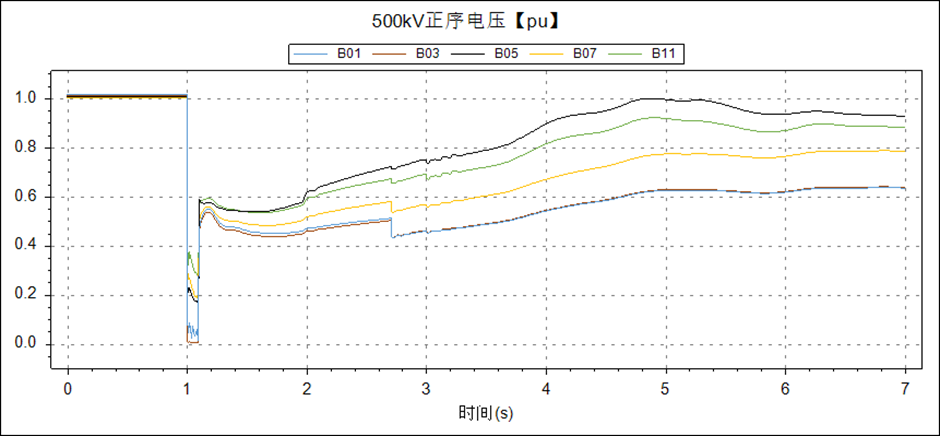
500kV Bus Voltage – BPA
CSEE-FS Frequency Stability Standard Case (1 set, 2 scenarios)
The CSEE-FS frequency stability case models a 500kV sending-end AC/DC network. Power is delivered via three ±500kV DC systems. For traditional frequency stability issues, scenarios with high and low frequency problems were constructed, with renewable capacity and output exceeding 50%. These serve as foundational cases for analyzing frequency stability of DC sending-end grids under high renewable penetration.

CSEE-FS System Topology
01 High-Frequency Scenario
When a DC lock fault occurs, the system experiences permanent power surplus. Generators endure a sudden electromagnetic power drop, producing a positive rate of change of frequency, leading to high-frequency issues. With HVDC-1 set to a bipolar lock fault, system frequency deviations of CloudPSS and BPA are shown below.
CloudPSS (Electromagnetic Transient) and BPA (Electromechanical Transient) both reproduce the high-frequency problem, with similar frequency deviations. Differences in model implementations and parameters cause minor detail variations.

System Frequency Deviation – CloudPSS

System Frequency Deviation – BPA
02 Low-Frequency Scenario
When a generator trip occurs, mechanical power decreases below electromagnetic power, causing negative accelerating power and a low-frequency scenario. Generator TP04 is tripped at 200MW; system frequency deviations from CloudPSS and BPA are shown below.
CloudPSS (Electromagnetic Transient) and BPA (Electromechanical Transient) both reproduce the low-frequency issue, with similar maximum frequency deviations. Differences in model implementations and parameters cause minor detail variations.

System Frequency Deviation – CloudPSS
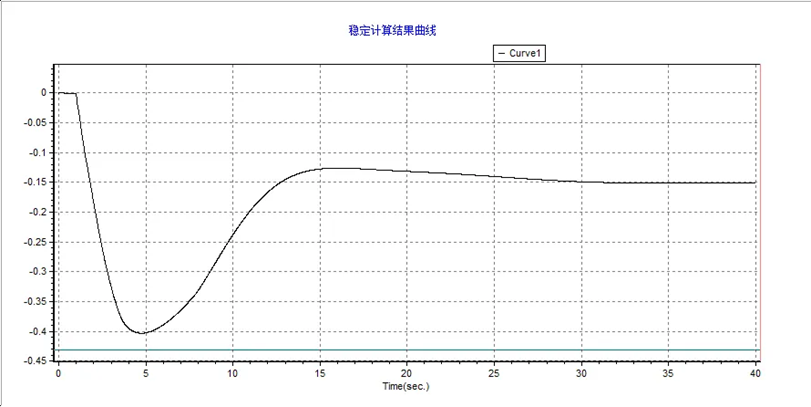
System Frequency Deviation – BPA
CSEE-PFO Power Frequency Overvoltage Standard Cases (2 sets)
The CSEE-PFO cases are based on a 500kV AC sending-end grid, including 2 thermal plants, 4 wind farms, 2 PV plants, and 2 synchronous condensers, with renewable penetration at 50.5%. These cases manually trigger DC locks to present different types of power frequency overvoltage, serving as foundational cases for overvoltage studies. The system topology is shown below.

CSEE-PFO System Topology
01 Steady-State Overvoltage Scenario
Set a 4s DC bipolar lock, 4.3s remove all AC filters at the converter station, 4.3s remove 1980MW of thermal units and 1600MW of renewable units, and 4.72s remove 200MW of renewable units. Even with all compensation and filters disconnected, post-fault voltages remain above 1.05 p.u.
CloudPSS (Electromagnetic Transient) and BPA (Electromechanical Transient) both reproduce the steady-state overvoltage issue. Differences in model implementations and internal parameters cause minor detail variations.

Bus Voltage Curve – CloudPSS

Bus Voltage Curve – BPA
02 Temporary Overvoltage Scenario
Set a 4s DC bipolar lock, 4.3s remove all AC filters at the converter station, 4.3s remove thermal and renewable units totaling 3300MW. CloudPSS and BPA both reproduce temporary overvoltage issues. Differences in model implementations and internal parameters cause minor detail variations.
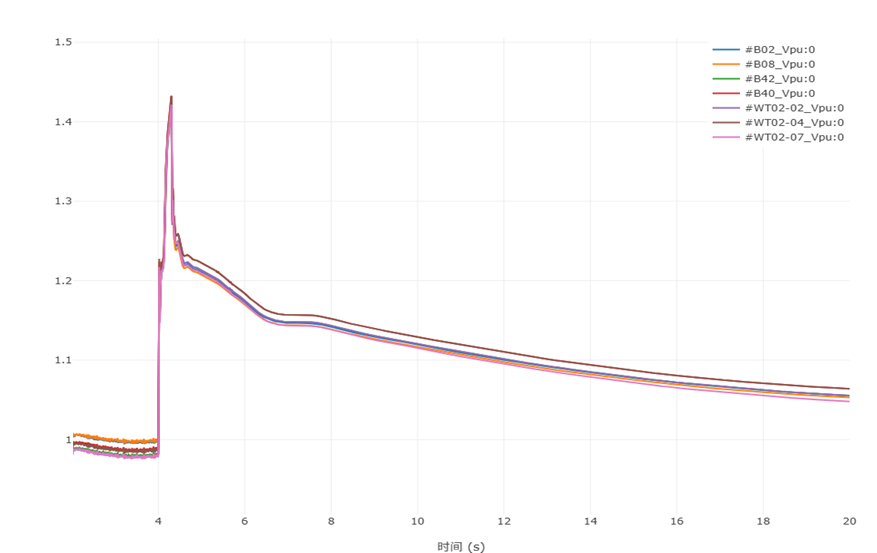
Bus Voltage Curve – CloudPSS

Bus Voltage Curve – BPA
References
https://www.csee.org.cn//portal/qtxx/20240921/33256.html
https://github.com/lbl-hub/CSEE
H. Sun, B. Zhao, S. Xu, T. Lan, Z. Li, and P. Wu, "Test Models for Stability/Security Studies of AC-DC Hybrid Power Systems With High Penetration of Renewables," IEEE Transactions on Power Systems, vol. 40, no. 1, pp. 957-969, Jan. 2025.
Xu Shiyun, Li Zonghan, Zhao Bing, et al., "New-Type Power System Standard Cases (I): Rotor Angle Stability CSEE-RAS," Proceedings of the Chinese Society for Electrical Engineering, 2024, 44(15): 5973-5985.
Wu Ping, Zhao Bing, Cheng Yi, et al., "New-Type Power System Standard Cases (II): Frequency Stability CSEE-FS," Proceedings of the Chinese Society for Electrical Engineering, 2024, 44(19): 7531-7542.
Zhao Bing, Xu Shiyun, Lan Tiankai, et al., "New-Type Power System Standard Cases (III): Voltage Stability CSEE-VS," Proceedings of the Chinese Society for Electrical Engineering, 2024, 44(21): 8353-8364.
Conclusion
CloudPSS now launches the OpenCloudPSS open-source test case project, continuously releasing a series of white-box model libraries for teaching, research, and system analysis support. We have opened renewable energy white-box structured models, CSEE standard cases, and networked energy storage cases, with more standard and research models to be released in the future.
We welcome more professional CloudPSS users to join us in improving the open-source model library. Stay tuned for more content!
Reprinted from the official WeChat account “CloudPSS Team”

















 News & Events
News & Events